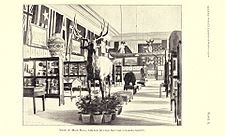| 1892–1893 Madrid | |
|---|---|
 The United States section of the main hall | |
| Overview | |
| BIE-class | Unrecognized exposition |
| Name | Historical American Exposition |
| Building(s) | Biblioteca Nacional de España/ National Archaeological Museum of Spain |
| Area | 5,000 square metres (0.50 ha) [1] |
| Organized by | Antonio Cánovas del Castillo [1] |
| Participant(s) | |
| Countries | 19 |
| Location | |
| Country | Spain |
| City | Madrid |
| Coordinates | 40°25′24″N 3°41′20″W / 40.423333°N 3.688889°W |
| Timeline | |
| Opening | 30 October 1892 |
| Closure | 31 January 1893 |
The 1892 Historical American Exposition held in Madrid was intended to mark the four hundredth year of the discovery of America. [2]
Participants
Several countries including Argentina, Bolivia, Colombia, Costa Rica, Denmark, Dominican Republic, Ecuador, Germany, Guatemala, Mexico, Nicaragua, Norway, Peru, Portugal, Sweden, Uruguay and USA participated, [3] along with the Captaincy General of Cuba and Spain herself. [3]
Costa Rica
The Costa Rica exhibit was organised by the National Museum of Costa Rica director Anastasio Alfaro and included over 1000 relics from an 1891 excavation of a cemetery at Guayabo de Turrialba. After the Madrid exhibition, much of the Costa Rican display was taken to the 1893 World's Columbian Exposition in Chicago. [3]
Mexico
The Mexican exhibit was curated by Francisco del Paso y Troncoso and included models of the El Tajín, Xochicalco, and Teuchitlan pyramids and of the complete Cempoala site. [4]
Spain
The Spanish section had many artefacts loaned from the National Archaeological Museum of Spain including the Troano codex [5]
See also
References
- ^ a b Watters, David R (2008). "Miadrid 1892". In Findling, John E; Pelle, Kimberley D (eds.). Encyclopedia of World's Fairs and Expositions. McFarland & Company. p. 113. ISBN 978-0-7864-3416-9.
- ^ "Cronología. National Library of Spain". 2014-08-11. Retrieved 5 May 2017.
- ^ a b c Watters, D.R. & Zamora, O.F., (2005). "World's Fairs and Latin American Archaeology: Costa Rica at the 1892 Madrid Exposition". Bulletin of the History of Archaeology. 15(1), pp.4–11. DOI: http://doi.org/10.5334/bha.15102
- ^ "Paper: Modeling Prehispanic Architecture at the Exposición Histórico-Americana, Madrid, 1892 (128th Annual Meeting (January 2-5, 2014))". Retrieved 5 May 2017.
-
^ United States. Commission to the Madrid Exposition, 1892 (1895). "Department of Spain. National Museum of Archaeology". Report of the United States Commission to the Columbian Historical Exposition at Madrid 1892-1893. Washington Government Printing Office. pp. 57–62.
{{ cite book}}: CS1 maint: numeric names: authors list ( link)
| 1892–1893 Madrid | |
|---|---|
 The United States section of the main hall | |
| Overview | |
| BIE-class | Unrecognized exposition |
| Name | Historical American Exposition |
| Building(s) | Biblioteca Nacional de España/ National Archaeological Museum of Spain |
| Area | 5,000 square metres (0.50 ha) [1] |
| Organized by | Antonio Cánovas del Castillo [1] |
| Participant(s) | |
| Countries | 19 |
| Location | |
| Country | Spain |
| City | Madrid |
| Coordinates | 40°25′24″N 3°41′20″W / 40.423333°N 3.688889°W |
| Timeline | |
| Opening | 30 October 1892 |
| Closure | 31 January 1893 |
The 1892 Historical American Exposition held in Madrid was intended to mark the four hundredth year of the discovery of America. [2]
Participants
Several countries including Argentina, Bolivia, Colombia, Costa Rica, Denmark, Dominican Republic, Ecuador, Germany, Guatemala, Mexico, Nicaragua, Norway, Peru, Portugal, Sweden, Uruguay and USA participated, [3] along with the Captaincy General of Cuba and Spain herself. [3]
Costa Rica
The Costa Rica exhibit was organised by the National Museum of Costa Rica director Anastasio Alfaro and included over 1000 relics from an 1891 excavation of a cemetery at Guayabo de Turrialba. After the Madrid exhibition, much of the Costa Rican display was taken to the 1893 World's Columbian Exposition in Chicago. [3]
Mexico
The Mexican exhibit was curated by Francisco del Paso y Troncoso and included models of the El Tajín, Xochicalco, and Teuchitlan pyramids and of the complete Cempoala site. [4]
Spain
The Spanish section had many artefacts loaned from the National Archaeological Museum of Spain including the Troano codex [5]
See also
References
- ^ a b Watters, David R (2008). "Miadrid 1892". In Findling, John E; Pelle, Kimberley D (eds.). Encyclopedia of World's Fairs and Expositions. McFarland & Company. p. 113. ISBN 978-0-7864-3416-9.
- ^ "Cronología. National Library of Spain". 2014-08-11. Retrieved 5 May 2017.
- ^ a b c Watters, D.R. & Zamora, O.F., (2005). "World's Fairs and Latin American Archaeology: Costa Rica at the 1892 Madrid Exposition". Bulletin of the History of Archaeology. 15(1), pp.4–11. DOI: http://doi.org/10.5334/bha.15102
- ^ "Paper: Modeling Prehispanic Architecture at the Exposición Histórico-Americana, Madrid, 1892 (128th Annual Meeting (January 2-5, 2014))". Retrieved 5 May 2017.
-
^ United States. Commission to the Madrid Exposition, 1892 (1895). "Department of Spain. National Museum of Archaeology". Report of the United States Commission to the Columbian Historical Exposition at Madrid 1892-1893. Washington Government Printing Office. pp. 57–62.
{{ cite book}}: CS1 maint: numeric names: authors list ( link)